Q&A – Ask Neil: November 30, 2023
(Please read these instructions carefully.)
Before you post your question, please look at recent issues to see if someone else has already asked it. You might find your answer there.
How to submit your question…
(Note: You may need to allow a pop-up window to come up in order to get the link for sending your photo(s). If you have already submitted your question and didn’t see the pop-up window, please click here.)
• Click the link provided below to post your question. After you submit your question, a new window will pop up giving you the address to which you can e-mail a SHARP, HIGH-RESOLUTION PHOTO to accompany your question. Please DO NOT SEND THUMBNAIL PHOTOS in case I need to zoom in to see things.
• Click here to post your question.
• Please ONLY POST YOUR QUESTION ONE TIME. We can only accept a set number of questions each week, and when we get duplicates it costs other people their chances.
• One question per reader, please.
• Please use this only for posting questions – not for standard emails.
• Watch for your answer in the following week’s e-gardens.
• I choose those of greatest general interest. For example, plant IDs seldom make the cut.
• I must have your first name or initials.
• I must have your city or county. (Texas is a very large state.)
QUESTION 1
WHAT EVERGREEN WOULD GROW 6-10 FT. TALL BUT STAY WITHIN OUR 10 FT. X 5 FT. BED?
Question: This photo is of the north side of our deck. We had Chinese palms planted there, but the past two winters killed them. The bed is 10 ft. x 5 ft. What evergreen plant would you suggest that would grow 6 to 10 ft. tall but that would not grow outside the bed? Mark M., Bexar County.
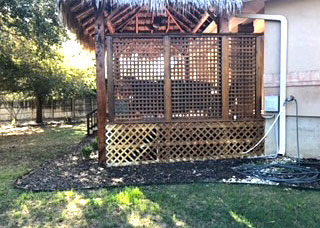
Answer: Oakland holly. The sizes are perfect if you’re looking for a tall, fairly narrow screening evergreen shrub. Plus, it’s readily available in all sizes and it’s super-dependable. My one admonition when recommending hollies is that they must be watered by hand for their first 2-3 years in their new homes. Drip and sprinkler irrigation will not be sufficient. Use a hose with a water bubbler and apply 8 or 10 gallons of water at least two or three times per week to each plant.
QUESTION 2
HOW CAN WE GET A PRETTY VITEX AGAIN?
Question: Our vitex shrub has gotten very leggy. It has new growth at the top but sparse limbs. It still blooms at the tips, but it’s not pretty at all. How do we prune it to get a fresh start, or should we just dig it out and start over? Evelyn M., Weatherford.
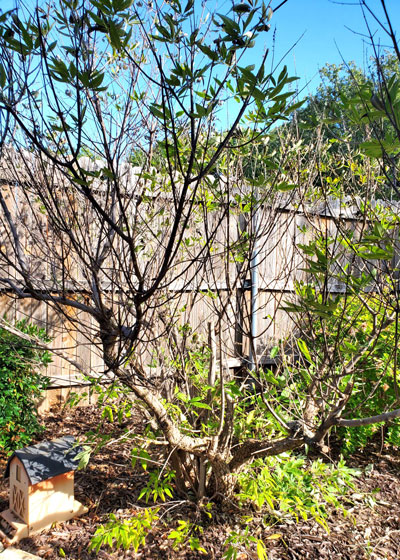
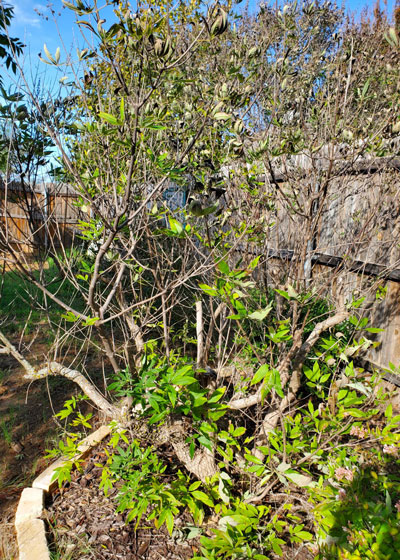
Answer: As I edited your photo before I read your question, I rather guessed that was going to be the help you’d be seeking. I’ve been thinking about how I would respond, and I still don’t have a good answer. I’m a big fan of vitex, but it does have some limitations. It is not a good plant for confined spaces (such as up against fences). And it only blooms one time in North Texas, and then only for 10 or 12 days. Folks in South Texas often coax them to bloom a second time by trimming them after the first round and encouraging a flush of new growth. But in North Texas (including Weatherford) there wouldn’t be enough time for the plants to grow and bloom a second time most years before frost.
But, to your answer. I would try removing all the older top growth almost to the ground – so that you don’t have to look at a bunch of stubs. Let those vigorous new shoots develop and see what you have by next summer. It will be easier to train them than it would be to retrain the old, gnarly growth. If that doesn’t work, you could replant with a new plant. Or, if you decide you want to get away from vitex entirely, how about a purple crape myrtle. They’re more upright and would clear the fence quite well. That’s assuming you went with a taller type such as (my favorite) Catawba and trained it tree-form. If you didn’t top it you could count on three or four rounds of blooms every summer.
QUESTION 3
HOW CAN I RESTORE DAMAGED COASTAL AND TIFWAY BERMUDA DESTROYED BY FERAL HOGS?
Question: My rural property has been over-run by feral hogs. Most of the damage was done to coastal bermuda (photos), but they’ve also gotten into our Tifway hybrid bermuda. How can we repair the damaged areas? Anthony E., Mansfield.
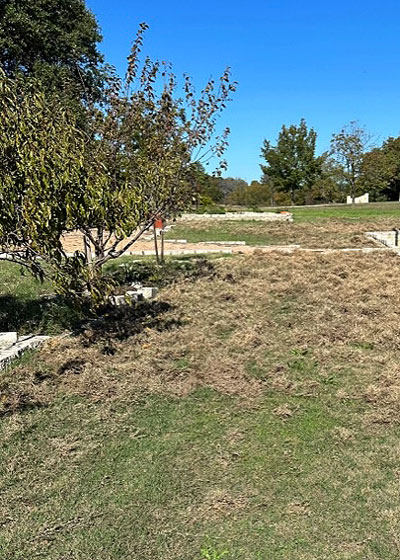
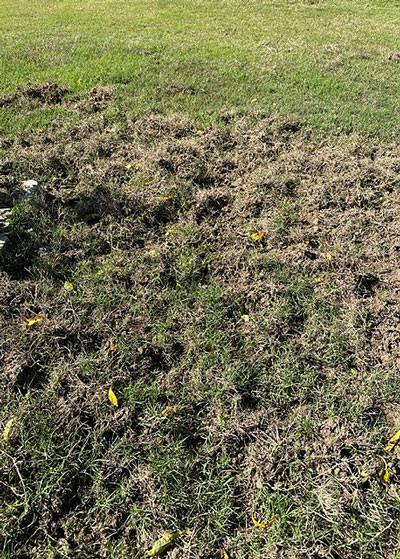

Answer: I am so sorry. Anyone who has not lived with the damage and destruction of feral hogs won’t believe its extent until they live it firsthand. (I have!) The loose divots are not going to survive being snouted up. You might as well drag/rake them up and discard them. Hopefully not much topsoil will be taken away in the process. In doing that hopefully the grade will be left fairly smooth. If not, you may have to bring some nutsedge-free topsoil in to fill any holes. Frankly, I might wait on that part until mid-spring. The grass won’t do any growing over the winter anyway, and your hogs will likely return unless you take steps to keep them out. No point in filling the holes multiple times. Hogs from our nearby lake areas have traditionally done most of their damage between October and April. Your County Extension Office will be the best place to get information on the hogs themselves – trapping and disposing of them. They are super-nasty. Be careful driving at night.
QUESTION 4
I DON’T HAVE A PRAYER WITH MY COMPOST.
Question: I live in Holly Lake Ranch with a wild yard. I read your story about the effect of oak leaves on growing plants. Omg! I don’t have a prayer out here! I’ve wondered why I was having such a challenging time growing things. I use compost in my gardens. Liz O., Wood.
Answer: Please re-read what I wrote (https://neilsperry.com/2023/11/thin-layer-composting/) Your oak leaves used as compost should have answered your prayers, not caused you angst. I grew up in College Station, and oak compost was the prime organic matter that I used in all my plantings. That photo I showed in my story is from our property. It is 100 percent oak and pecan compost and it’s fabulous. I think you read it incorrectly.
QUESTION 5
WHAT ARE THE LITTLE RED BERRIES ON THE UNDERSIDES OF MY OAK LEAVES?
Question: What are the little red berries on the bottom sides of my oak leaves? They are making a huge mess. This is the first time for this to happen, and we have lived in this house for three years. Kay T., Granbury.
Answer: Please see this answer in last week’s e-gardens https://neilsperry.com/2023/11/qa-ask-neil-november-23-2023/. They are harmless insect galls for which we have no means of preventing or curing.
QUESTION 6
WHY ARE MY PECANS EITHER ROTTING OR SPROUTING BEFORE THEY FALL?
Question: My pecans are splitting and trying to root before they drop. The husks are still mostly green, but they either seem rotten or they are rooting when I get pecans that seem to be mature. I tried to water regularly – at least every other day during the drought. Larry S., Montgomery.
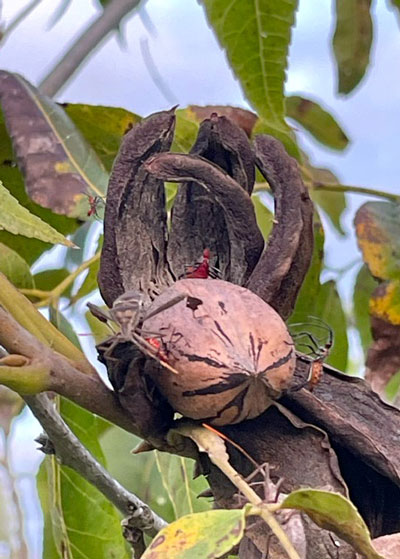
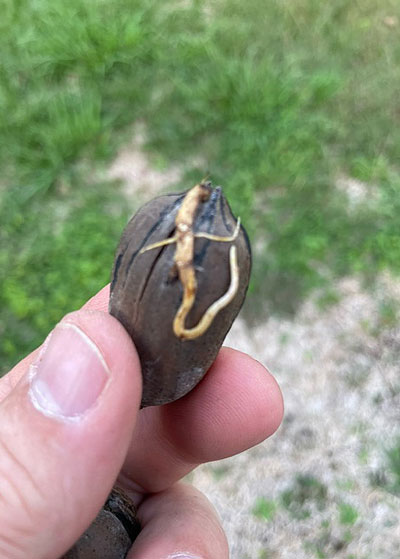
Answer: This is a “malfunction” called “vivipary” where germination occurs before a seed actually falls to the ground. It happens with some varieties of pecans more than others, also under certain conditions of temperature and soil moisture. High temperatures seem to favor it, as do heavy crops, so thinning is recommended for commercial producers. Here is a news release (granted from 20 years ago, but some things don’t change much) from the U.S.D.A. It will give you much more information. You will find several other technical research papers online if you care to search for “vivipary in pecans” online.
QUESTION 7
OUR TREE RINGS ARE FALLING APART. SHOULD I REPAIR THE RINGS?
Question: We have two live oaks. Their tree rings are breaking apart. Should I repair the rings? One landscaper suggests removing the trees and replanting with new trees that are not set as high. Do you have a recommendation? Bob W., Prosper.
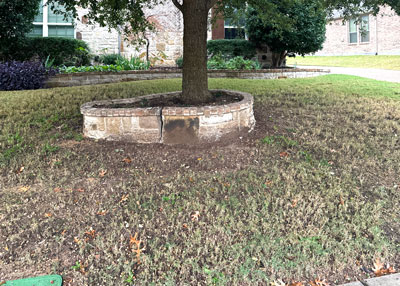
Answer: Tree rings cause more problems! They are almost never good for trees. I notice that your bermuda turf is thinning between the ring and the sidewalk, so at a minimum I would not have the ring repaired. You’re soon going to “outgrow” the ring and need a larger bed. If I bought your house and moved in tomorrow, I would take the rings away and see what I had with the roots within them. I’d use a nozzle with pressure to wash any soil I couldn’t remove with a shovel. Doing so won’t harm the trees as long as you don’t cut the major roots. Then I would consider enlarging the bed and using low shrubs and/or tall groundcover plants to conceal the roots and to replace the grass. You could even remove one or two roots if they were just too obvious and unattractive. By feathering the bed down gradually, I think you can make it look gradual and more natural. I would absolutely prefer that to taking the trees out entirely. If you do, however, opt to remove the trees, have someone dig them with a tree spade and reuse them somewhere. Maybe they could even be reset back into the same spots in your landscape, just 8 or so inches deeper (whatever the heights of the rings are). The trees are assets that should not be destroyed. Good luck. Hope that helps.
